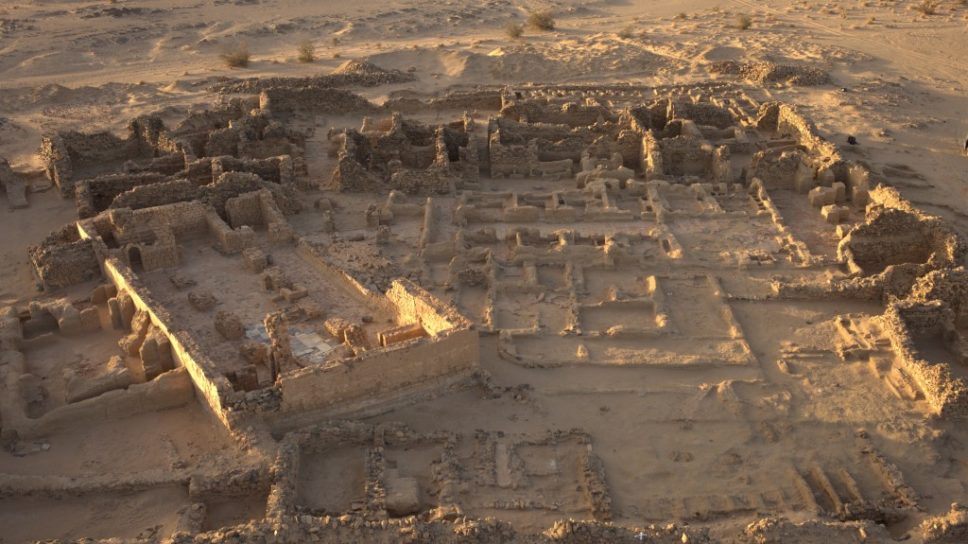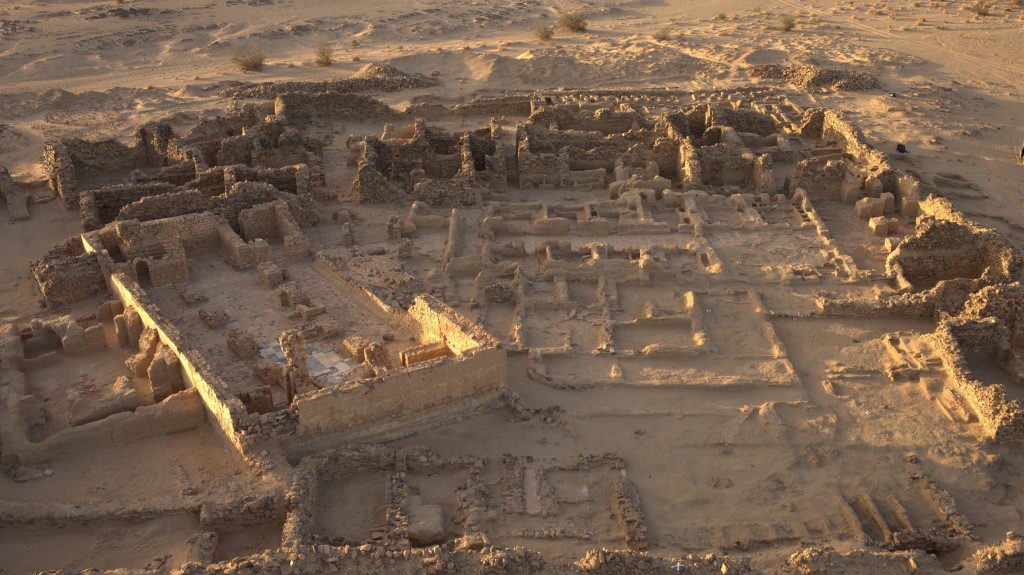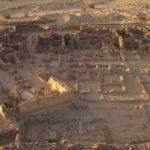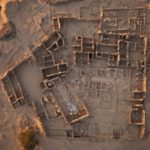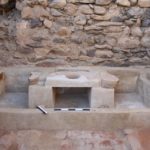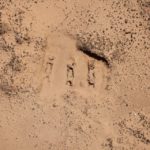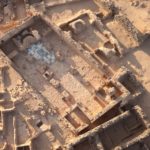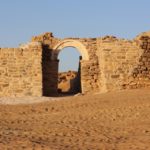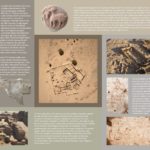Ghazali
-
Project name:
Ghazali Archaeological Site Presentation Project
Project website:
www.nubianmonasteries.uw.edu.pl
www.virtualnubia.uw.edu.plType of site:
Monastic site
-
Location:
Sudan
Northern Province
Bayuda Desert
Near the city of KarimaDating:
– Medieval period (7th–13th century)
Most interesting finds:
– Very well-preserved cenobitic monastic complex
– 137 inscriptions in the Northern Church
– 93 funerary inscriptions
– Two monk figurines of fired clay
History of research:
Dates of PCMA mission’s work:
2012–2018
Type of research:
Excavations, conservation and site presentation
Directors:
Artur Obłuski
Co-operating institutions:
– Polish Centre of Mediterranean Archaeology, University of Warsaw
– National Corporation of Antiquities and Museums of Sudan
– Qatar-Sudan Archaeological Project
– Qatar Museums Authority
– Westfälische Wilhelms-Universität Münster
Additional information:
Qatar-Sudan Archaeological Project’s grant: Ghazali Archaeological Site Presentation Project
National Science Centre’s grant Sonata 7: “Nubian monasticism. The role of religious institutions in the peripheries of the Byzantine world” no. 2014/13/D/HS3/03829
In the 19th century, the site attracted numerous travelers, including Linant de Bellefonds, Richard Lepsius, Sir John Gardner Wilkinson, and Pierre Trémaux. The first excavation works in Ghazali were carried out by Peter Shinnie and Neville Chittick (1953–1954), who uncovered a church and several buildings associated with it.
Description of the site and research:
The archaeological site of Ghazali lies in northern Sudan, about 20 km from the modern town of Karima. The research focuses on the medieval Christian monastery (7th–13th century), founded probably by king Merkurios, and on the remains of a small village, cemeteries, and iron-smelting sites associated with it. Concurrently, the team works on preparing the site for visitors.
The center of monks’ spiritual life inside the monastery consisted of two churches: Northern and Southern. The Northern Church, a typical Makurian church, was erected presumably between 680 and 720, with a basilical layout. In the first phase, it had three aisles and a flat roof resting on arches supported by granite columns. The lower parts of walls were built of sandstone, the upper of baked brick. The painted decoration that covered them was preserved only in two rooms. The Southern Church, built entirely of mud bricks at the turn of the 11th century, had a trapezoidal plan. Its naos was not tripartite, which is unusual for Makurian architecture. Elements of furnishing, such as a synthronon (a bench for clergy in the sanctuary) or a pulpit, have been preserved in both churches.
On the walls of the Northern Church, 137 inscriptions have been recorded. They provide important information on the life of monks and on the visitors to the monastery. Another interesting find are two terracotta figurines of monks made of fired clay. Their purpose is not clear; they might have been devotional objects brought by pilgrims from some holy place. However, the inscriptions and the figurines are the only indications of the existence of a pilgrimage movement in Ghazali; no hard evidence for this has been found.
Two metallurgical centers contemporary with the monastery were discovered nearby. The construction of the iron-smelting furnaces was unusual: air vents were located in the upper part, while a pottery slab in the lower part facilitated the outflow of slag. Inside the monastery, there was a refectory (dining room), as well as installations for food production, including a mill with silos and an oil press – the only such relics known from Nubia. The dormitories were located in a separate mud-brick building. In its heyday, the monastery could accommodate approximately 70 monks in triple bedrooms. There were also two sanitary complexes with bathrooms and several dozen latrines.
The monastery in Ghazali fell gradually into decline in the second half of the 12th century and ceased functioning in the third quarter of the 13th century.
The Polish-Sudanese mission to Ghazali conducted work also outside the monastery, e.g., on three cemeteries where more than 2,000 burials were recorded. Particularly intensive archaeological research was carried out on Cemetery 2, thought to be the burial place of monks inhabiting the monastery. Approximately 800 graves, representing different architectural forms, were discovered here. Fragments of funerary inscriptions, found both in the necropolis and in the monastery, form the second-largest set of written sources of this type known from medieval Nubia.
Research results:
Season by season – “PCMA Newsletter”:
- 2018 season
- 2017 season
- 2016 season
- 2015 season
- 2014 season
- 2013 season
- 2012 season
2023-10 A rare medieval tattoo from Ghazali, Sudan
2022-03 Methods and Monks – bioarchaeological public engagement events in Khartoum
2020-09 Virtual Nubia: visit a medieval monastery on your screen
2020-06 National Geographic Society Explorers Grant for archeogenetic research at Ghazali
2016-01 Lecture on new epigraphic finds from Ghazali in PCMA Research Centre in Cairo
Ciesielska, J.A., Stark, R.J., Obłuski, A., Korzeniowska, M., (in press). Dietary transgressions? Investigation of diet among the monks of Ghazali, northern Sudan, in: Publication of the Proceedings of International Conference Continuities and Transitions: Approaches to Studying Food & Drink in Egypt & Sudan, March 21st–23rd 2017, Polish Centre of Mediterranean Archaeology Research Centre in Cairo, University of Warsaw and Institut français d’archéologie orientale, Cairo, Egypt
Ciesielska, J.A., Stark, R.J., Obłuski, A., Boivin, N.,Lucas, M., Le Roux, P., Roberts, P.,(2023). Multi-Isotopic Investigation of Population Dynamics and Mobility among Rural Medieval Christian Communities at Ghazali, Northern Sudan, Journal of African Archaeology, 1-23, doi:https://doi.org/10.1163/21915784-bja10028
Ochała, G., (2023). Life and Death at a Nubian Monastery. The Collected Funerary Epigraphy from Ghazali, Nubia, vol. 2, Brepols
Ciesielska, J.A., Stark, R.J., Obłuski, A., Boivin, N., Roberts, P., (2021). Multi-isotope analysis of dietary variation among the early Christian communities of northern Sudan, Journal of Archaeological Science: Reports, 37, doi.org/10.1016/j.jasrep.2021.103016
Stark, R.J., Ciesielska, J.A., and Obłuski, A. (2021) An Isotopic Assessment of Makurian Monastic Diet at the Medieval Nubian Monastery of Ghazali, Sudan (Ca. 680–1,275 CE). Archaeometry, https://doi.org/10.1111/arcm.12674
Ciesielska, J.A., Stark, R.J. (2020). Proximal femur fractures among a medieval Christian population of northern Sudan: prevalence and aetiology, International Journal of Osteoarchaeology 30.2, https://doi.org/10.1002/oa.2894
Ciesielska, J.A., Stark, R.J. (2020). Possible neurogenic disorder in a female buried in the monastic cemetery at Ghazali (ca. 670-1270 CE), International Journal of Osteoarchaeology 30.1, 33–42, https://doi.org/10.1002/oa.2828
Stark, R., Ciesielska, J.A. (2019). Vertebral infection in a male individual buried in the monastic cemetery (Cemetery 2) at Ghazali (ca. 670–1270 CE), northern Sudan, International Journal of Paleopathology 24, 34–40
Stark, R., Ciesielska, J.A. (2018). Cemetery 4 at Ghazali (Sudan): Excavations during the Fall 2016 Season, in: A. Lohwasser, T. Karberg, J. Auenmüller (eds), Bayuda Studies. Proceedings of the First International Conference on the Archaeology of the Bayuda Desert in Sudan (Meroitica), Westfälische Wilhelms–Universität Münster Institut für Ägyptologie und Koptologie, Münster, 273–284
Ciesielska, J., Obłuski, A., Stark, R. (2018). The Cemeteries of Ghazali, Season 2015/2016, in: A. Lohwasser, T. Karberg, J. Auenmüller (eds), Bayuda Studies. Proceedings of the First International Conference on the Archaeology of the Bayuda Desert in Sudan (Meroitica), Westfälische Wilhelms–Universität Münster Institut für Ägyptologie und Koptologie, Münster, 257–272
Obłuski, A. (2018). El-Ghazali – a royal monastery in Northern Sudan?, Sudan and Nubia 22, 155–166
Obłuski A., Ciesielska J., Stark R., Chlebowski A., Misiurny A., Żelechowski-Stoń M., el-Din Mahmoud Z. (2018). Qatar-Sudan Archaeological Project: Excavations at the Ghazali monastery from 2014 to 2016, Polish Archaeology in the Mediterranean 27/1, 245–271
Obłuski, A., Ochała, G., Calaforra-Rzepka, C., Korzeniowska, M., Maślak, S., & ed-Din Mahmoud, E. (2017). The winter seasons of 2013 and 2014 in the Ghazali monastery. Polish Archaeology in the Mediterranean, 26/1, 367–398. https://doi.org/10.5604/01.3001.0012.1795
Obłuski, A., Ochała, G., (2016). La redécouverte d’un monastère nubien: premiers résultats des fouilles polonaises à Ouadi el-Ghazali, Actes de la seizième Journée d’études coptes, Genève 19–21 juin 2013 (=Études coptes XIV), 63–80
Obłuski, A., Ochała, G., Bogacki, M., Małkowski, W., Maślak, S., & ed-Din Mahmoud, Z. (2015). Ghazali 2012: preliminary report. Polish Archaeology in the Mediterranean, 24/1, 431–442. https://doi.org/10.5604/01.3001.0010.0085
Obłuski, A., (2014). Ghazali Site Presentation Project preliminary results, Der Antike Sudan. Mitteilungen der Sudanarchäologischen Gesellschaft zu Berlin e.V, 25, 197–205
Gallery:
-
Kite view of the Ghazali monastery / Widok na klasztor w Ghazali (Fot. M. Bogacki)
-
The Ghazali monastery seen from a kite / Klasztor w Ghazali widziany z latawca (Fot. M. Bogacki)
-
Room Y after restoration / Pomieszczenie Y po konserwacji (Fot. Archiwum CAŚ UW)
-
Iron smelting furnaces / Piece do wytopu żelaza (fot. M. Bogucki)
-
Churches of the Ghazali monastery; kite photo / Kościoły klasztoru w Ghazali na zdjęciu z latawca (Fot. M. Bogacki)
-
Reconstructed main gate to the monastery / Zrekonstruowana główna brama klasztoru (Fot. Archiwum CAŚ UW)
-
Voices from the Nile valley – wystawa: Ghazali

